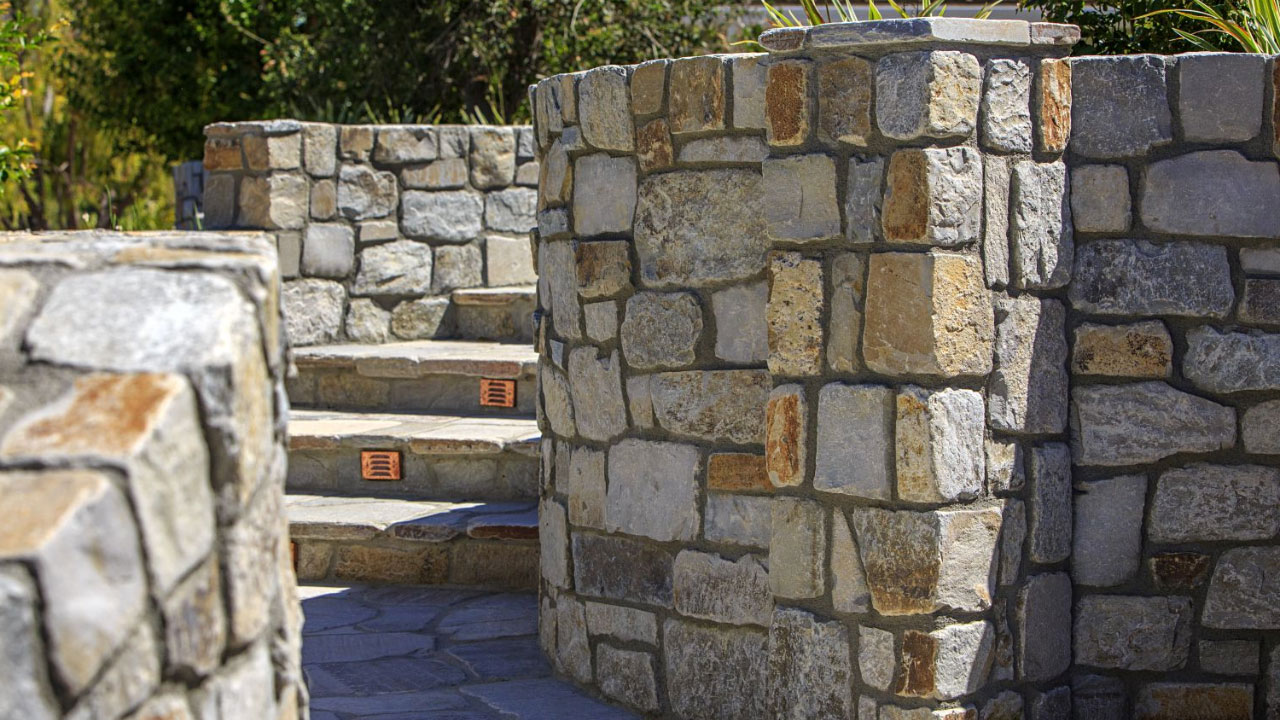Key Takeaways:
- Choose recycled concreteRecycled concrete, also known as crushed concrete, is an eco-friendly material made from the remnant..., natural stone, reclaimed woodReclaimed wood is timber that has been salvaged from old buildings, barns, or other structures and r..., or eco-friendly blocks to reduce environmental impact.
- Consider site assessment, terracingTerracing is the process of creating stepped levels on a sloped landscape to reduce soil erosion, ma..., drainage systems, and native vegetation for a retaining wall that works with the environment.
- Reduce excavationExcavation is the process of removing earth, rock, or other materials from a site to create space fo..., use low-impact machinery, and implement erosion controlErosion control involves implementing strategies and techniques to prevent soil erosion, which can l... measures to lessen construction footprint.
- Achieve long-term durability, cost savings, aesthetic appeal, and regulatory compliance with eco-friendly retaining wallsRetaining walls are structures designed to hold back soil and prevent erosion in landscapes with var....
- Use vegetation, geotextilesGeotextiles are permeable fabrics used in landscaping to improve soil stability, provide erosion con..., and proper drainage for erosion control and incorporate features to encourage wildlife habitation.
Retaining walls are essential structures in landscaping and construction, providing support and preventing soil erosion. However, their construction can significantly impact the environment if not carefully planned.
By working with a knowledgeable hardscape contractor, you can design and build a retaining wall that not only serves its practical purpose but also minimizes environmental impact.
This blog explores various strategies and considerations to achieve this goal.
Sustainable Materials for Retaining Walls
One of the first steps in minimizing the environmental impact of a retaining wall is choosing sustainable materials.
Traditional materials such as concreteConcrete is a composite material made from a mixture of cement, sand, gravel, and water. It is one o... and treated lumber can significantly harm the environment. However, greener alternatives are available:
- Recycled Concrete: This reduces the need for new concrete production, which is energy-intensive and a major source of CO2 emissions.
- Natural Stone: Requires minimal processing and is often locally sourced, reducing transportation emissions.
- Reclaimed WoodWood is a natural, organic material derived from trees, commonly used in landscaping and constructio...: Salvaged wood from old structures can be repurposed, minimizing the need for new lumber and preventing deforestation.
- Eco-Friendly Blocks: Some manufacturers offer blocks made from recycled materials or sustainably sourced aggregates.
By opting for these materials, a hardscape contractor can significantly reduce the environmental impact of your retaining wall.
Design Considerations for Environmental Efficiency
Proper design plays a crucial role in minimizing the environmental impact of a retaining wall. Here are several design considerations to keep in mind:
- Site Assessment: Conduct a thorough site assessment to understand the natural landscape and water flow. This helps in designing a retaining wall that works with the environment rather than against it.
- Terracing: Instead of a single, large wall, consider terracing with multiple smaller walls. This reduces the pressure on each wall and blends more naturally with the landscape.
- Drainage Systems: Incorporate efficient drainage systems to prevent water buildup and erosion. Permeable materials and French drainsFrench drains are a type of subsurface drainage system designed to redirect water away from problem ... can help manage water sustainably.
- Vegetation: Planting vegetation on and around the retaining wall can help stabilize the soil, reduce erosion, and enhance the aesthetic appeal. Choose native plantsNative plants are species that naturally occur in a specific region or ecosystem without human intro... that are well-suited to the local climate.
Techniques to Reduce Construction Impact
The construction phase of a retaining wall can have significant environmental impacts. Here are some techniques to mitigate these effects:
- Minimize Excavation: Reduce the amount of soil disturbed during construction. This helps preserve the natural habitat and reduces erosion.
- Use Low-Impact Machinery: Select machinery and equipment that have a smaller environmental footprint, such as electric or hybrid machines.
- Erosion Control Measures: Implement erosion control measures such as silt fences, erosion control blankets, and temporary vegetation to prevent soil loss during construction.
Benefits of Environmentally Friendly Retaining Walls
Designing retaining walls with minimal environmental impact offers several benefits beyond sustainability:
- Long-Term Durability: Sustainable materials and smart design create more durable structures. They also need less maintenance over time.
- Cost Savings: Eco-friendly materials may cost more initially. However, they save money long-term due to lower maintenance and replacement costs.
- Aesthetic Appeal: Natural materials and plants enhance your landscape's beauty. They make your outdoor space more attractive and harmonious.
- Regulatory Compliance: Many areas have rules and incentives for sustainable building practices. Designing an eco-friendly retaining wall helps you comply with regulations and benefit from possible incentives.
Key Points for Environmentally Friendly Retaining Walls
- Sustainable Materials: Use recycled concrete, natural stone, reclaimed wood, and eco-friendly blocks.
- Efficient Design: Conduct site assessments, consider terracing, incorporate effective drainage systems, and use native vegetation.
- Construction Techniques: Minimize excavation, use low-impact machinery, and implement erosion control measures.
- Long-term Benefits: Achieve durability, cost savings, aesthetic appeal, and regulatory compliance.
Implement Erosion Control Measures
Erosion control is a primary function of retaining walls. Effective erosion control techniques can enhance the environmental benefits of your retaining wall:
- Vegetation: Planting native vegetation on and around the retaining wall helps stabilize the soil and absorb excess water.
- Geotextiles: These permeable fabrics can reinforce the soil and promote drainage, preventing erosion behind the wall.
- Drainage Systems: Proper drainage is crucial to prevent water buildup behind the wall, which can lead to erosion and wall failure. Perforated pipes and gravelGravel consists of small, loose, rounded or angular stones, typically ranging in size from a few mil... backfills are common solutions.
Incorporating these measures ensures that your retaining wall effectively prevents erosion. They also support a healthy ecosystem at the same time.
Promote Biodiversity
A well-designed retaining wall can contribute to local biodiversity. Here are some ways to achieve this:
- Green WallsGreen walls, also known as living walls or vertical gardens, are structures covered with vegetation ...: Integrate planting pockets within the retaining wall to grow small plants, herbs, or succulentsSucculents are a group of plants known for their thick, fleshy leaves or stems that store water, mak.... These green walls provide habitats for insects and small wildlife.
- Pollinator-Friendly PlantsPollinator-friendly plants are species that attract and support pollinators, such as bees, butterfli...: Choose plants that attract bees, butterflies, and other pollinators. This supports local wildlife and promotes biodiversity.
- Habitat Features: Incorporate elements like birdhouses, bat boxes, or insect hotels into the wall design to encourage wildlife habitation.
By promoting biodiversity, your retaining wall can become a thriving part of the local ecosystem.
Reduce Carbon FootprintA carbon footprint is the total amount of greenhouse gases, primarily carbon dioxide (CO2), that are...
Construction activities contribute significantly to carbon emissions. Here are some strategies to reduce the carbon footprint of your retaining wall project:
- Local Sourcing: Use locally sourced materials to reduce transportation emissions.
- Energy-Efficient Equipment: Utilize energy-efficient machinery and techniques during construction to minimize energy consumption.
- Minimal Excavation: Design the wall to fit the natural contours of the land, reducing the need for extensive excavation and gradingGrading is the process of reshaping the land surface to achieve a specific slope or contour, often f....
These strategies help ensure that the construction process is as environmentally friendly as possible.
Practical Tips for Homeowners
For homeowners looking to minimize the environmental impact of their retaining walls, here are some practical tips:
- Work with Experienced Contractors: Choose Aliso Viejo hardscape contractors who have experience with eco-friendly construction practices. They can guide you through the process and ensure your project meets environmental standards.
- Plan for the Long Term: Consider how your retaining wall will interact with the environment over time. Plan for future vegetation growth and potential changes in water flow. This will ensure long-term stability and environmental harmony.
- Regular Maintenance: Regularly inspect your retaining wall for signs of wear and tear. Prompt repairs can prevent larger issues and maintain the wall's environmental benefits.
Real-World Examples
To illustrate the impact of eco-friendly retaining walls, here are a few real-world examples:
- Residential Gardens: Homeowners often use natural stone and recycled materials to build retaining walls. These walls blend seamlessly with garden landscapes, promoting biodiversity and adding aesthetic appeal.
- Community Parks: Public spaces frequently adopt terraced retaining walls with integrated vegetation. These walls manage erosion and enhance the area's natural beauty.
- Commercial Properties: Businesses are increasingly using sustainable pavement hardscapingHardscaping refers to the non-living elements of landscaping, such as stone, brick, concrete, wood, ... techniques for retaining walls. This reduces their environmental footprint and appeals to eco-conscious customers.
Embrace Eco-Friendly Landscaping with West Hills Masonry
Creating an environmentally friendly retaining wall doesn't mean compromising on aesthetics or functionality. With West Hills Masonry, you can achieve a beautiful, durable, and sustainable retaining wall that enhances your outdoor space.
Call us today at 714-519-5009 to learn more about our services and how we can help you design and build an eco-friendly retaining wall. Our experienced hardscape contractors are ready to transform your landscape into a harmonious blend of beauty and sustainability.

 Carlos Gonzales
Carlos Gonzales